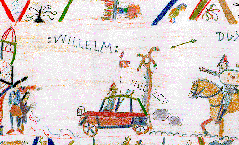2CV History Tour
..
The Early Years:
Before 1940
1935
Following the collapse of his
car company, a victim of the great depression, Andre
Citroen died of ill health. He was never to drive the car
bearing his name that was to revolutionize motoring.
However, all was not lost for the company, and it was
subsequently bought out by The Michelin Tyre Company. Two
engineers; Pierre Boulanger and Pierre Michelin, were put
in charge of the company.
1936
Pierre Boulanger (then 51)
recognized the need for an affordable, reliable means of
transport, for the "common man". It was then
that he produced the famous design brief that was to lead
to the birth of the 2 CV. Although opinions disagree upon
the exact requirements, the basic idea was to provide an
affordable, economical means of transport, which was to
be extremely simple to drive and maintain. The vehicle
had to be capable of transporting 4 adults (all wearing
hats and clogs!), and 50 kg of potatoes, in complete
comfort over even the poorest roads. It is often said
that the car was designed to carry a basket of eggs
across a ploughed field without damaging a single egg,
and prototypes which failed this were instantly
rejected.
It could, of course, be argued that
providing affordable transport for the masses would
create a new market for (Michelin) tyres, and this was,
indeed, to be a great advantage for Michelin.
1937
Following a great deal of market research and a number of designs, Pierre Boulanger, and Andre Lefebvre (designer of the "Traction Avant") produced the very first Prototype. This vehicle was named "T.P.V.", or "Tout Petite Voiture" (very small car), and was the predecessor of the modern 2 CV, with which it shared many design features, and its basic shape.
- All aluminium body and chassis with 4 doors, and a canvas roof. Acrylic plastic windows to save weight, flipped up for hand signals.
- Flat twin engine; water cooled BMW unit of 300cc.
- Top speed of 35 m.p.h. (55 km/h).
- Magnesium alloy suspension arms, torsion bar springs.
- Canvas "hammock" seats, suspended on aluminium tubes.
- Single headlight.
Although the vehicle fitted the original requirements, it was still considered too heavy, and was difficult and unpredictable to drive. A great deal of further research and development were to follow, which would result in a more useable product.
1939
By this time, several prototypes had been produced and exhaustively tested (in secret) and ongoing development led to a vehicle bearing more resemblance to the 2 CV of today. A number of these were constructed, to be launched the following year. However, shortly afterwards, war was declared in Europe. This was the start of World War 2, and most of the vehicles were destroyed, with only a few being placed in storage, where they were to remain for a number of years.
The People
| Andre Citroen (1878 - 1935) | Pierre Boulanger (1885 - 1950) | Pierre Michelin ( ) | Andre Lefebvre (1894 - 1964) |
